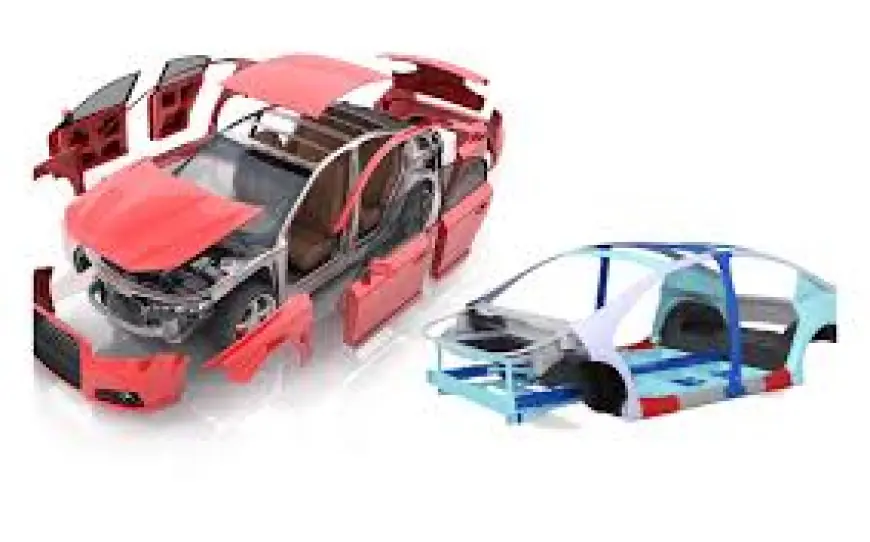Global Lightweight Automotive Body Panel Market 2030 Share
Governments worldwide are implementing stringent emission standards, compelling automakers to develop fuel-efficient and lightweight vehicles.

The Global Lightweight Automotive Body Panel Market, valued at USD 75 Billion in 2024, is expected to grow at a CAGR of 6.3%, reaching nearly USD 110 Billion by 2030. The demand for lightweight automotive components is at the forefront of the automotive industry’s transformation, primarily driven by the urgent need to reduce vehicle weight, enhance fuel efficiency, and meet stringent emission standards. With rising concerns over climate change, energy efficiency, and sustainability, lightweight materials such as aluminum, carbon fiber, high-strength steel, and composites are gaining prominence in modern automotive manufacturing.
This comprehensive analysis explores the current market dynamics, key drivers, emerging trends, industry highlights, competitive landscape, and future outlook of the Lightweight Automotive Body Panel Market.
Market Overview
The automotive industry is undergoing a fundamental shift towards sustainability and efficiency. Lightweight automotive body panels—comprising bumpers, hoods, doors, trunk lids, and other external vehicle parts—are now integral to achieving global regulatory targets for emission reduction and energy efficiency.
The increased adoption of aluminum, magnesium, polymers, carbon fiber, and reinforced plastics is revolutionizing vehicle design, enabling automakers to improve fuel economy without compromising safety and durability. At the same time, the rise of electric vehicles (EVs) has accelerated the demand for lightweight materials to offset battery weight and extend driving range.
Download Free Sample Report: https://www.techsciresearch.com/sample-report.aspx?cid=28130
Emerging Trends in the Lightweight Automotive Body Panel Market
1. Electrification and EV Adoption Driving Lightweighting
With EVs becoming mainstream, automakers are adopting lightweight materials to compensate for the heavy weight of lithium-ion batteries. Reducing the body structure weight by even a small percentage can significantly extend driving range, making lightweight panels a strategic priority.
2. Sustainability and Recyclable Materials
There is a growing shift toward eco-friendly, recyclable composites and bio-based materials. Automakers are experimenting with plant-based polymers and recycled carbon fibers, aligning with global commitments to reduce carbon footprints.
3. Advanced Manufacturing Techniques
Technologies such as 3D printing, hot stamping, and resin transfer molding (RTM) are enhancing production efficiency. These methods lower costs while maintaining material integrity, enabling the mass adoption of lightweight panels.
4. Integration with Smart and Connected Vehicles
Lightweight panels are increasingly designed with integrated sensors and electronic systems, supporting autonomous driving, vehicle safety, and telematics. This integration adds both value and complexity to the market.
5. Regional Shifts in Manufacturing
The Asia-Pacific region, led by China, India, Japan, and South Korea, is emerging as the fastest-growing hub for lightweight material adoption due to high automotive production, government regulations, and investments in green mobility.
Key Market Drivers
1. Regulatory Push for Fuel Efficiency and Emission Control
Governments worldwide are mandating stricter emission norms (Euro 7, CAFE standards, BS-VI). Lightweight body panels help automakers reduce vehicle weight by up to 20–25%, improving fuel efficiency and lowering CO₂ emissions.
2. Rising Demand for Electric and Hybrid Vehicles
As EV adoption surges globally, lightweight materials are critical to counterbalance battery mass. This not only enhances efficiency but also ensures improved safety and durability.
3. Technological Innovations in Material Science
Advancements in high-strength steel, advanced polymers, aluminum alloys, and composites are delivering lightweight yet strong panels. These innovations improve cost efficiency and scalability, encouraging mass production.
4. Growing Consumer Preference for Performance and Sustainability
Modern consumers demand vehicles that are fuel-efficient, eco-friendly, and high-performing. Lightweight materials fulfill this dual need, positioning them as a premium feature in both passenger cars and commercial vehicles.
5. Cost Reduction in Long-Term Vehicle Ownership
Though initial production costs may be higher, lightweight vehicles deliver lower fuel costs, better durability, and reduced emissions penalties, making them economically viable in the long term.
Market Segmentation
By Vehicle Type
- Passenger Cars: Increasing adoption of lightweight body panels to meet emission regulations and consumer demand for sustainable, fuel-efficient vehicles.
- Commercial Vehicles: Trucks and buses are integrating lightweight materials to improve fuel economy, reduce operating costs, and comply with green regulations.
By Component Type
- Bumpers
- Hood Panels
- Door Panels
- Trunk Lids
- Others (fenders, roof panels)
By Material Type
- Metals (Aluminum, Magnesium, High-Strength Steel)
- Polymers & Composites
- Glass Fiber Reinforced Plastics (GFRP)
- Carbon Fiber Reinforced Plastics (CFRP)
By Region
- North America: Driven by EV adoption and stringent CAFÉ standards.
- Europe: Pioneering emission regulations and lightweight technology adoption.
- Asia-Pacific: Fastest-growing, led by China, Japan, and India.
- Latin America & Middle East: Gradual adoption, primarily in luxury and high-performance vehicles.
Industry Key Highlights
- Market Size 2024: USD 75 Billion
- Forecast 2030: USD 110 Billion
- CAGR (2024–2030F): 6.3%
- Fastest Growing Region: Asia-Pacific
- Major Growth Drivers: Emission regulations, EV adoption, sustainability push
- Top Materials in Use: Aluminum, carbon fiber, high-strength steel, composites
Competitive Analysis
The Lightweight Automotive Body Panel Market is highly competitive, with players focusing on innovation, partnerships, and large-scale production capacity.
Major Players:
- ArcelorMittal – Global leader in advanced lightweight steels for automotive applications.
- Toray Industries, Inc. – Specializes in high-performance carbon fiber composites.
- Magna International Inc. – Offers integrated lightweighting solutions across body structures.
- Covestro AG – Innovator in advanced polymers and composites for vehicles.
- Alcoa Corporation – Leading supplier of aluminum-based lightweight panels.
- SGL Carbon SE – Carbon fiber and composite technology leader.
- Aleris Corporation – Specializes in aluminum rolled products for automotive.
- ThyssenKrupp AG – Develops high-strength steels and lightweight alloys.
- LyondellBasell Industries Holdings B.V. – Advanced polymers provider.
- Teijin Limited – Pioneer in carbon fiber reinforced plastics.
Competitive Strategies Include:
- Heavy investments in R&D and advanced material science.
- Collaborations with automotive OEMs for co-development of solutions.
- Expansion into EV-focused lightweight technologies.
- Sustainable manufacturing and recycling initiatives.
Future Outlook
The future of the Lightweight Automotive Body Panel Market looks highly promising as the global automotive industry undergoes rapid electrification, digitalization, and decarbonization. By 2030, lightweight body panels will no longer be an option but a necessity for compliance, efficiency, and competitiveness.
Key aspects of the future outlook include:
- Widespread adoption in EVs and hybrids, with carbon fiber and composites becoming mainstream.
- Integration of smart panels with sensors for autonomous and connected mobility.
- Greater affordability as production costs decline with mass adoption.
- Expansion in Asia-Pacific and Europe, the two most progressive regions for lightweighting initiatives.
- Growth in recyclable and bio-based lightweight materials, supporting circular economy goals.
10 Benefits of the Research Report
- Provides comprehensive market size, trends, and forecasts up to 2030.
- Analyzes emerging materials such as carbon fiber, composites, and alloys.
- Offers segmentation insights by vehicle type, component, material, and region.
- Identifies market drivers, restraints, and growth opportunities.
- Covers regulatory landscape and impact on lightweight adoption.
- Highlights competitive strategies of leading global players.
- Examines regional dynamics, with special focus on Asia-Pacific’s growth.
- Provides future outlook for EV-driven demand.
- Supports decision-making with data-backed forecasts.
- Enables customized insights for OEMs, suppliers, and investors.
Conclusion
The Global Lightweight Automotive Body Panel Market is set to witness robust expansion over the next decade, reaching USD 110 Billion by 2030. With regulatory mandates, consumer expectations, and EV adoption shaping the future of mobility, the role of lightweight body panels will be pivotal in defining automotive competitiveness. Companies that invest in innovation, sustainability, and smart lightweighting technologies are expected to lead this transformation.
As the automotive industry embraces a new era of sustainability, efficiency, and electrification, lightweight body panels are no longer just an engineering solution—they are the backbone of future-ready vehicles.
Contact Us-
Mr. Ken Mathews
708 Third Avenue,
Manhattan, NY,
New York – 10017
Tel: +1-646-360-1656
Email: [email protected]
Website: www.techsciresearch.com
What's Your Reaction?
 Like
0
Like
0
 Dislike
0
Dislike
0
 Love
0
Love
0
 Funny
0
Funny
0
 Angry
0
Angry
0
 Sad
0
Sad
0
 Wow
0
Wow
0


















































